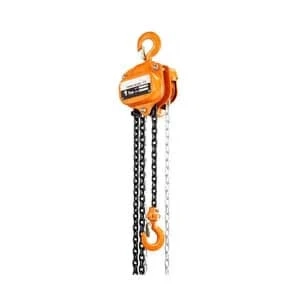A chain pulley block is used in various production and operations facilities for both lifting heavy objects and moving. Because chain pulley blocks are operated by hand, inspecting them before use is an integral part of your daily maintenance routine to avoid mishaps and inefficiency in work. Inspecting chain pulley blocks helps ensure that your blocks are safe to use and maintain the production cycle successfully.
Before we learn how to conduct a pre-inspection of a chain pulley block, you must understand why this procedure is necessary. Read on to know!
Why Is Pre-inspection of a Chain Pulley Block Necessary?
• Pre-inspection of chain pulley blocks is critical to avoid injury to operating personnel or damage while lifting or moving.
• A daily pre-inspection can result in optimum work efficiency and long life for your manual chain hoist.
Now the main part of the article –
How to Conduct a Pre-inspection of a Chain Pulley Block?
Here are the components of a chain pulley you must inspect as a hoist operator, which falls under the pre-inspection procedure. It would be best if you did this before operating a chain pulley block.
1. The Name Plate
First, make sure the nameplate is firmly attached to the chain pulley block. The nameplate contains pertinent data such as rated capacity or permitted load, which must be legible to any operator. If the nameplate is damaged and the load-related information is challenging to read, toss away (or replace) your block.
For instance, the IB Basics Chain Pulley Block has a lifting capacity weight of 2 tons. If the nameplate is clean, the operator can read all the necessary information before carrying out any activity.
IB Basics 2 Ton, 3 Metre Light Weight Chain Pulley Block
2. The Hooks
Hooks and latches are the most important part of any chain pulley. Examine each hook and latch it to see if
• The hook latch is tightly fastened to the device.
• The hook latch operates smoothly and efficiently.
• The chain hook is freely rotating with no impediment.
• The chain hook is free of gouges, nicks, and other forms of deformation.
• The chain hook is not warped as a result of being exposed to high temperatures.
Depending on its dimensions, each chain hook has a suggested rated load. Replace it when the chain hook\'s dimensions exceed the maximum allowable limits.
3. The Load & Hand Chains
The load and the hand chains are the next components to be inspected (used by the operator). Both of these chains must be in good working order for your chain pulley block to operate safely and smoothly.
Here\'s everything you need to look at:
• If any of the chain links are coiled, stretched, or otherwise deformed?
• If there is any severe deterioration throughout the chain?
• Does the chain have any scratches, gouges, or discoloration induced by extreme heat?
• If the chains have been appropriately lubricated?
Any damage to the chain, whether caused by overloading or poor maintenance, can cause it to break during operation. Furthermore, if the hoist has two or more chain falls, please check for any chain twists by inspecting the chain hoist from below. If the chain has been coiled, your bottom chain hook has most likely been flipped over. In this case, turn it back to its original position.
4. The Chain Hoist Body
Next, investigate the appearance of your chain hoist body. Major flaws in the hoist body can cause parts to fall off while lifting or dropping heavy loads.
Here\'s everything you need to look at:
• Does your hoist body have any significant dents or deformations due to excessive use or loads?
• Does your hoist have any rusted parts due to rain or moisture exposure?
• Are any of your hoist nuts or bolts loose, dislocated, or missing?
Post-inspection of a Chain Pulley Block
After you have concluded the pre-inspection of your chain hoist, verify for regular operation in the following ways:
• When manually lifting the chain, make sure the chain pulley block makes a "clicking" sound.
• Check to see if the pull force on your chain is natural – and if you don\'t need to apply extra force to pull up any load.
• Once the hand chain operation is stopped, your lifted load remains at the same height or position.
If any of these functions aren\'t functioning right, your chain hoist may have some internal issues. Here\'s what you need to do to prevent any injuries caused by a malfunctioning hoist:
• With immediate effect, stop using your equipment.
• Sign your chain hoist with a label or tag indicating that it is currently unavailable. (This is to warn another chain operator not to use the defective hoist by accident.)
• Create a service maintenance ticket as soon as possible so that the service or upkeep engineer can attend to the damaged equipment.
• Finally, make sure that every chain hoist technician in your facility is aware of these pre-inspection procedures in order to ensure the safety of all your workers and maximise productivity.
The Fulcrum 1 Ton 3 Mtr Chain Pulley Block 1T3M has a capacity of 1 ton with a 3-metre chain.
Conclusion
To ensure there’s zero to minimum damage to your chain pulley, go for a high-quality product from www.industrybuying.com, a marketplace for buyers and sellers with more than 1.2 lakh of industrial products. The chain pulley blocks at Industry Buying have a high-grade finish and a sturdier build to ensure minimum mishaps. The blocks start at Rs 2,600 with bulk discounts on bulk purchases. We\'re running additional up to 70% off sitewide, so for all your industrial goods needs, Industry Buying should be your go-to place.
0



